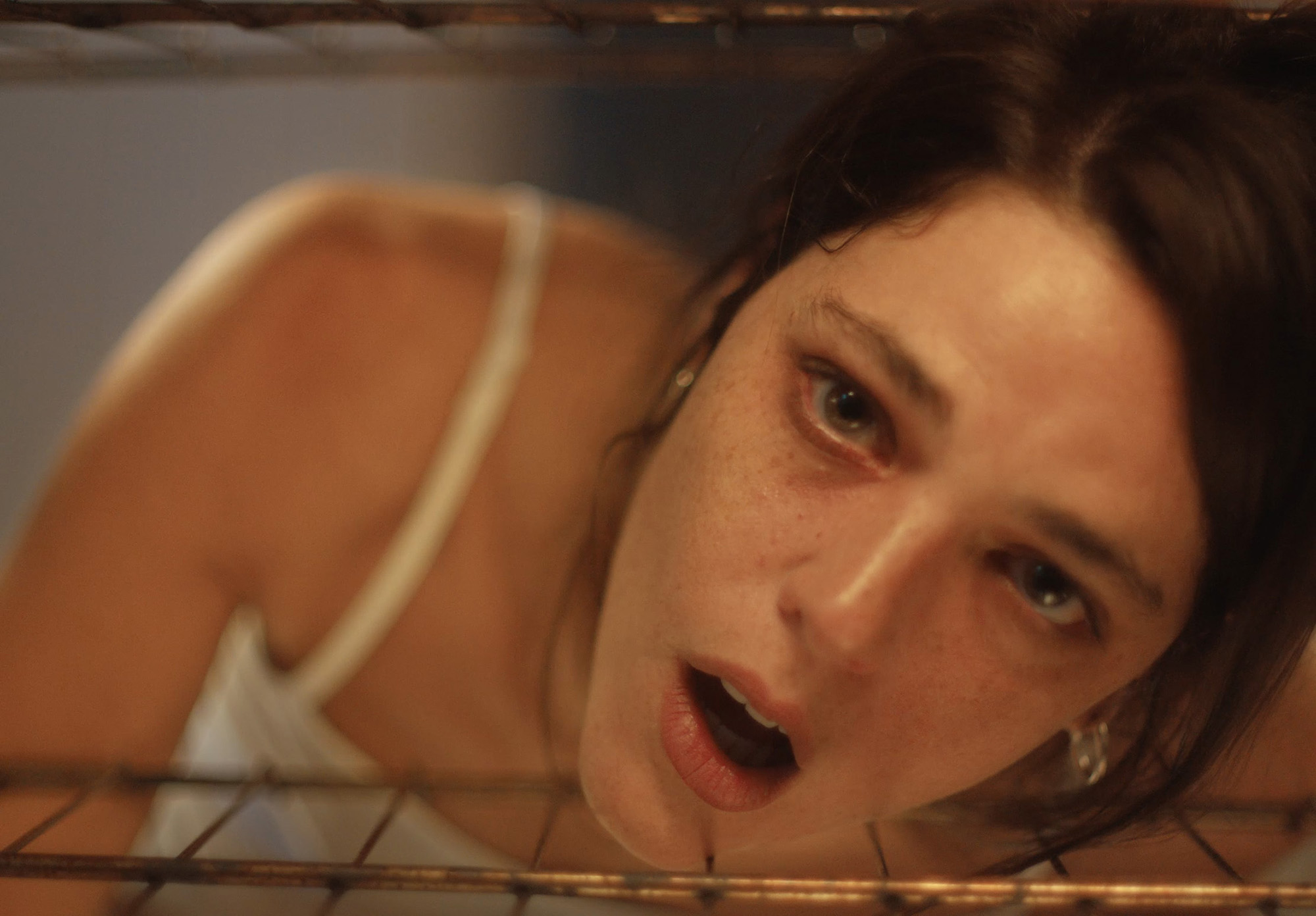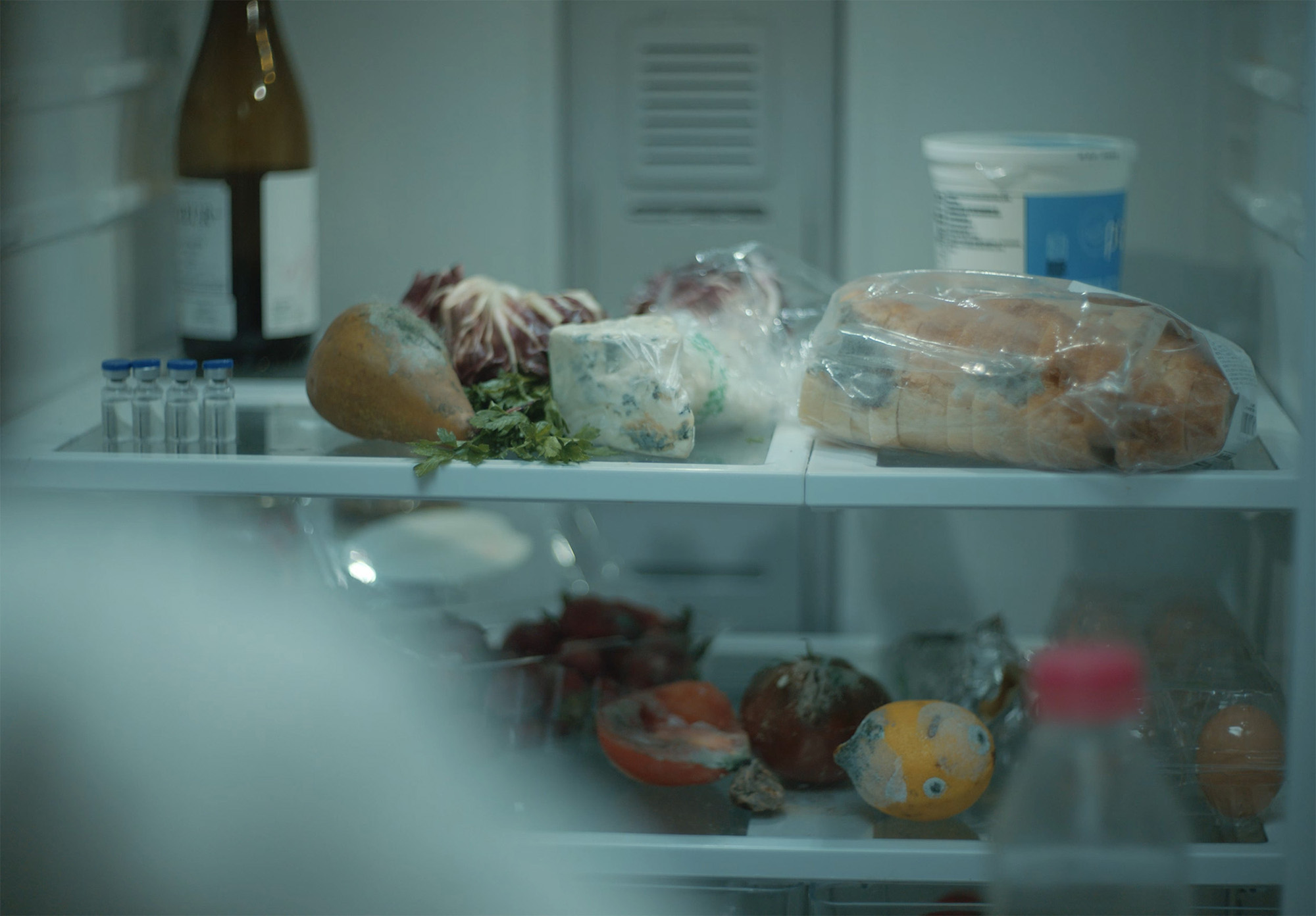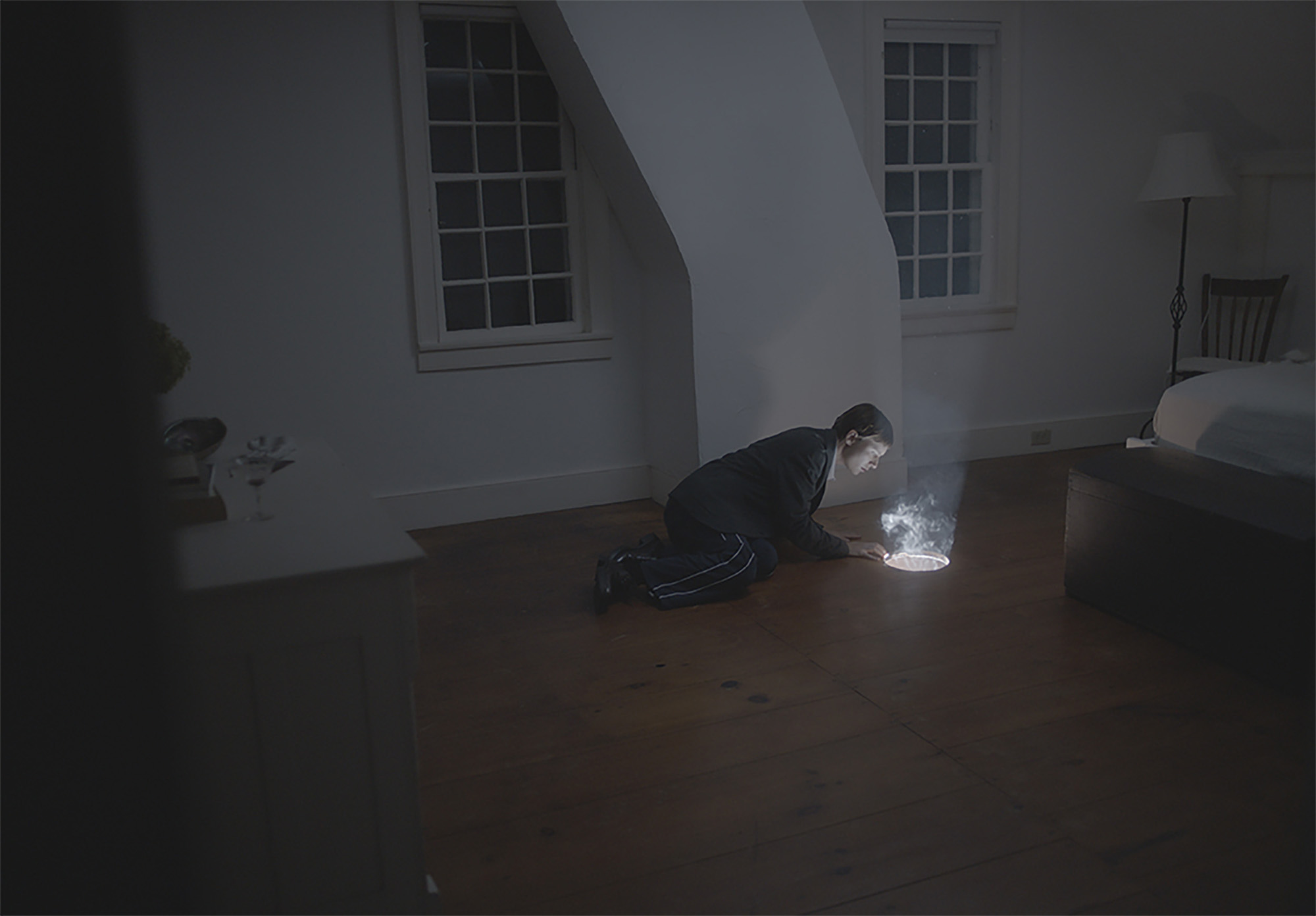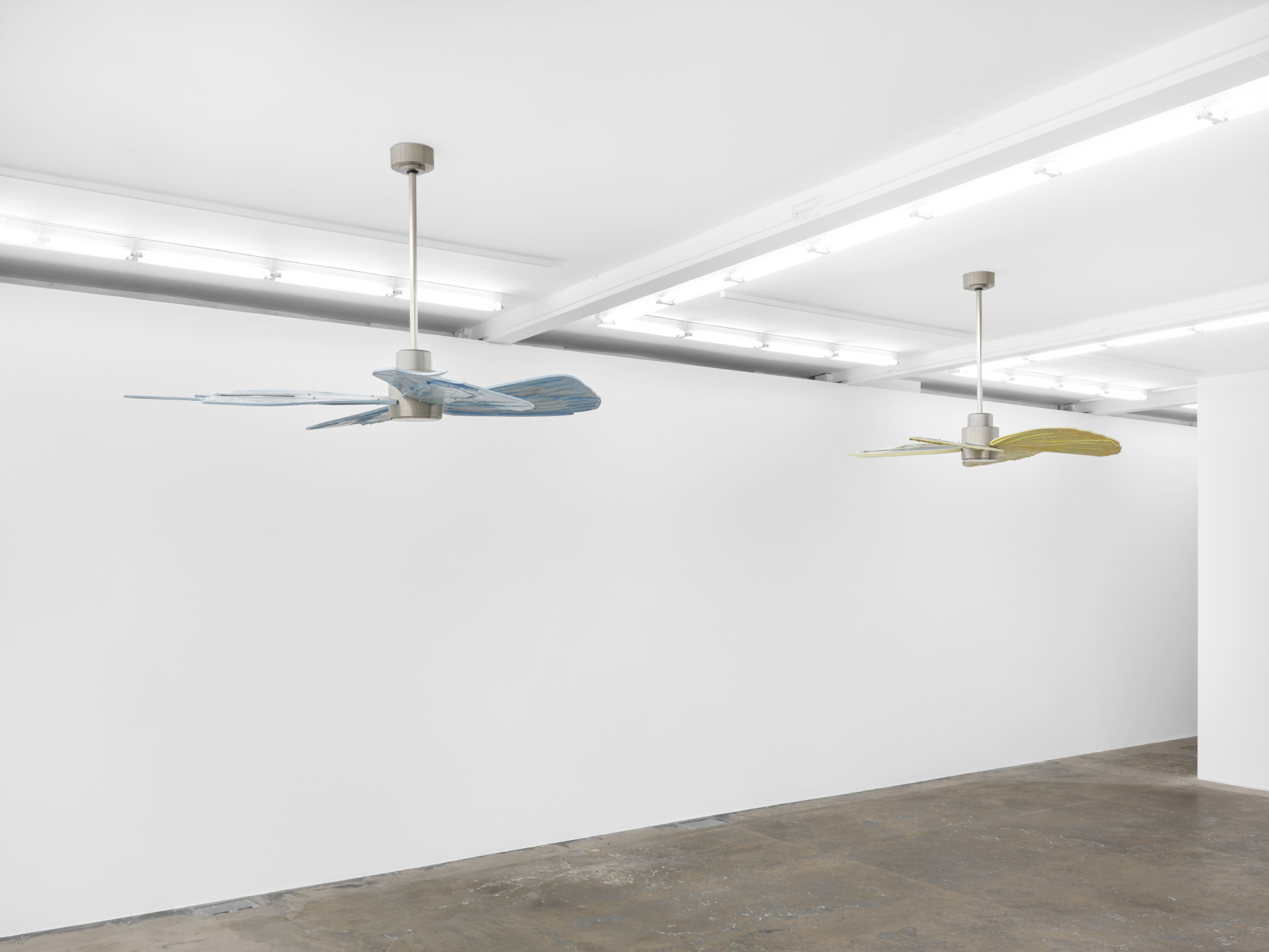Living architecture: Olivia Erlanger’s
Fan Fiction
At Soft Opening gallery in London, American artist Olivia Erlanger
continues her exploration of uncanny, anxiety-inducing compressions of nature
& the built environment. Here, butterfly wing fans slowly rotate, while a
film presents a domestic environment as living architecture with its own creepy
personality, as Rochelle Roberts discovered.
At first sight, Olivia Erlanger’s
exhibition, Fan Fiction at London’s Soft Opening gallery, seems to lack
stimulation. Upon entering the gallery, the visitor is confronted with an
almost empty room – bare white walls, a cold concrete floor, harsh overhead
lighting. From the ceiling, four fans spin into the void – except the fans’ blades
are not as expected, but resin butterfly wings of different colours: blue,
pink, yellow, green.
It concocts an uneasy feeling, these four spinning fans hovering overhead a starkly empty gallery, a sense almost sinister, strange, and uncanny. The environment feels completely controlled, as if the visitor entered a building that they should not be in. Perhaps the uneasiness is connected to the conflation of nature and the man-made – these four oversized butterflies disguised as ordinary office appliances.
![]()
![]()
The rotating sculptures build on Erlanger’s interests in the domestic and an interrelation between nature and the built environment, interior and exterior worlds, and how the everyday meets the fantastical. A previous work, Pergusa (2019), shown at Frieze New York considered the interplay between machines and the non-human world by combining a commercial washing machine with a large fish – or mermaid – tail hanging out. In a similar vein, the four butterfly sculptures consider how interior and exterior environments can converge in a subversive and controlled way.
Out of this, comes Erlanger’s ongoing engagement with the idea of “closed worlds,” a term created by architect and scholar Lydia Kallipoliti to describe man-made environments which are contained and detached, sealed off from the natural, outside world. Within these worlds, artificial ecologies exist, as well as the interaction between machines and animals.
![]()
![]()
![]()
![]()
Although simulating nature, Erlanger’s butterfly wings look synthetic rather than lifelike. They are reminiscent of plastic wings attached to the backs of Barbie dolls, not at all the delicate, thin constructions of actual butterflies, playing into the idea of a synthetic nature borne out of Kallipoliti’s closed worlds. Erlanger pushes this artificiality further by using everyday domestic objects such as a wastepaper bin, a kitchen utensil holder, and a shower curtain rod to construct these butterfly fans.
More than this, it also disrupts the viewer’s expectation of the fan as a functional object within an interior space. These fans, although spinning continually, do not manage to stimulate any air flow. Instead, they are set to the lowest possible speed, therefore failing in their function as cooling devices, blurring the line between object and insect, man-made and nature.
![]()
![]()
![]()
![]()
![]()
The functionality of domestic objects is further explored in Erlanger’s short film Appliance (2024), shown alongside Fan Fiction. In it, the protagonist, Sophie, moves into a new home but very quickly discovers the house is working against her. She becomes haunted by the objects that inhabit the space with her. These objects do not behave as they should but rather, subvert our expectations of them in a similar way to Erlanger’s fans. Although the fridge is brand new, when Sophie opens the door, she finds all her food is mouldy.
The fridge seemingly unplugs itself from the wall, and when Sophie tries to plug it back in, it shocks her with electricity. She goes to wash up her dishes and the tap pours mirky black water. When she turns on the lights, they do not work, and she is forced to use a torch. The film reaches a head when Sophie opens her oven, a bright light emitting from within. She half climbs in, searching for something, or being drawn in by an invisible force, and when she emerges again in her kitchen all her neatly arranged appliances appear on the floor surrounding her.
![]()
![]()
In using the house as a malevolent, haunting presence, it is almost as if it is living architecture, with its own agenda, its own impulses. While so often humans force themselves onto buildings – altering them to suit their needs – in Appliance, this relationship works in reverse. Sophie looks into a mirror and her face is momentarily branded by a plug. In that moment she becomes part of the house, a meeting point between nature and a controlling interior environment. The house itself is like a closed world. Sophie never ventures outside but stays trapped within the confines of the walls, questioning her reality while the house plays tricks on her. When a medium friend comes over and puts her in a trance-like state, Sophie sees herself not in the house, but outside, where snow falls silently around her. It is an outside to which she is cut off from.
Fan Fiction does the job of subverting expectations on various counts. You enter the exhibition expecting more than what you are given – it is a gallery disguised as an empty, office-like room. The fans similarly work against our expectations, and against their function, to act as strange uncanny objects that bridge the gap between appliance and nature. Erlanger’s film pushes this unease, giving us a disorderly house with a mind of its own, the artist creating an anxious atmosphere while also playing with a human desire to control our environment – we are not able to control the gallery space; Sophie cannot control her home.
It concocts an uneasy feeling, these four spinning fans hovering overhead a starkly empty gallery, a sense almost sinister, strange, and uncanny. The environment feels completely controlled, as if the visitor entered a building that they should not be in. Perhaps the uneasiness is connected to the conflation of nature and the man-made – these four oversized butterflies disguised as ordinary office appliances.


Figs.i,ii
The rotating sculptures build on Erlanger’s interests in the domestic and an interrelation between nature and the built environment, interior and exterior worlds, and how the everyday meets the fantastical. A previous work, Pergusa (2019), shown at Frieze New York considered the interplay between machines and the non-human world by combining a commercial washing machine with a large fish – or mermaid – tail hanging out. In a similar vein, the four butterfly sculptures consider how interior and exterior environments can converge in a subversive and controlled way.
Out of this, comes Erlanger’s ongoing engagement with the idea of “closed worlds,” a term created by architect and scholar Lydia Kallipoliti to describe man-made environments which are contained and detached, sealed off from the natural, outside world. Within these worlds, artificial ecologies exist, as well as the interaction between machines and animals.




Figs.iii-vi
Although simulating nature, Erlanger’s butterfly wings look synthetic rather than lifelike. They are reminiscent of plastic wings attached to the backs of Barbie dolls, not at all the delicate, thin constructions of actual butterflies, playing into the idea of a synthetic nature borne out of Kallipoliti’s closed worlds. Erlanger pushes this artificiality further by using everyday domestic objects such as a wastepaper bin, a kitchen utensil holder, and a shower curtain rod to construct these butterfly fans.
More than this, it also disrupts the viewer’s expectation of the fan as a functional object within an interior space. These fans, although spinning continually, do not manage to stimulate any air flow. Instead, they are set to the lowest possible speed, therefore failing in their function as cooling devices, blurring the line between object and insect, man-made and nature.





Figs.vii-xii
The functionality of domestic objects is further explored in Erlanger’s short film Appliance (2024), shown alongside Fan Fiction. In it, the protagonist, Sophie, moves into a new home but very quickly discovers the house is working against her. She becomes haunted by the objects that inhabit the space with her. These objects do not behave as they should but rather, subvert our expectations of them in a similar way to Erlanger’s fans. Although the fridge is brand new, when Sophie opens the door, she finds all her food is mouldy.
The fridge seemingly unplugs itself from the wall, and when Sophie tries to plug it back in, it shocks her with electricity. She goes to wash up her dishes and the tap pours mirky black water. When she turns on the lights, they do not work, and she is forced to use a torch. The film reaches a head when Sophie opens her oven, a bright light emitting from within. She half climbs in, searching for something, or being drawn in by an invisible force, and when she emerges again in her kitchen all her neatly arranged appliances appear on the floor surrounding her.


Figs.xiii,xiv
In using the house as a malevolent, haunting presence, it is almost as if it is living architecture, with its own agenda, its own impulses. While so often humans force themselves onto buildings – altering them to suit their needs – in Appliance, this relationship works in reverse. Sophie looks into a mirror and her face is momentarily branded by a plug. In that moment she becomes part of the house, a meeting point between nature and a controlling interior environment. The house itself is like a closed world. Sophie never ventures outside but stays trapped within the confines of the walls, questioning her reality while the house plays tricks on her. When a medium friend comes over and puts her in a trance-like state, Sophie sees herself not in the house, but outside, where snow falls silently around her. It is an outside to which she is cut off from.
Fan Fiction does the job of subverting expectations on various counts. You enter the exhibition expecting more than what you are given – it is a gallery disguised as an empty, office-like room. The fans similarly work against our expectations, and against their function, to act as strange uncanny objects that bridge the gap between appliance and nature. Erlanger’s film pushes this unease, giving us a disorderly house with a mind of its own, the artist creating an anxious atmosphere while also playing with a human desire to control our environment – we are not able to control the gallery space; Sophie cannot control her home.
Olivia Erlanger (b. 1990, New York) lives and works in Los
Angeles. The artist’s first solo institutional exhibition in the US If Today
Were Tomorrow, is now open at Contemporary Arts Museum, Houston. Recent and
forthcoming solo exhibitions include Humour in the Water Coolant at
Institute of Contemporary Art, London (2024); Appliance at Kunstverein
Gartenhaus, Vienna (2022); Home is a Body at Soft Opening, London
(2020); Split-level Paradise at Bel Ami, Los Angeles (2020); Ida at
Motherculture, Los Angeles (2018); Poison Remedy Scapegoat (with Nikima
Jagudajev) at Human Resources, Los Angeles (2018) and mouths filled with
pollen at And Now, Dallas (2018). Recent group exhibitions include Nonmemoryat Hauser & Wirth, Los Angeles (2023); On Failure at Soft
Opening, London (2023); The Heavy Light Show at Night Gallery, Los Angeles
(2022); The Kick Inside at Museum X, Bejing (2022); Shell at Del Vaz
Projects, Santa Monica (2022); Liquid Life at Kistefos Museum, Jevnaker
(2021); Psychosomatic at Various Small Fires, Los Angeles (2021); In
Situ at Marianna Boesky Gallery, New York (2021); Winterfest at
Aspen Art Museum, Aspen (2020); Haunted Haus at Swiss Institute, New
York (2020); DIS Presents: What do people do all day? at Kunsthalle
Charlottenborg, Copenhagen (2020); No Space, Just a Place at Daelim
Museum, Seoul (2020) and For a dreamer of houses at Dallas Museum of
Art, Dallas. Erlanger and Luis Ortega Govela co-wrote Garage (MIT Press,
2018), a secret history of the attached garage as a space of creativity, from
its invention by Frank Lloyd Wright to its use by start-ups and garage bands.
The following year Erlanger and Ortega Govela made a feature-length documentary
based on the publication, which screened at the ICA London and on Dis.art.
Erlanger’s second book Appliance, made in conjunction with the artist’s
solo exhibition at Kunstverein Gartenhaus, Vienna, was published this year.
www.oliviaerlanger.com
Rochelle Roberts is
a writer and editor based in London. Her writing has been published by
Prototype, Arusha gallery, Poetry Birmingham Literary Journal, Art of Choice,
and Maximillian William gallery, amongst others. Her debut pamphlet Your
Retreating Shadow was published in 2022 by Broken Sleep Books and she
is a contributor to the book Cusp: Feminist Writings on Bodies, Myth
& Magic (Ache, 2022).
www.rocheller.weebly.com
www.rocheller.weebly.com


